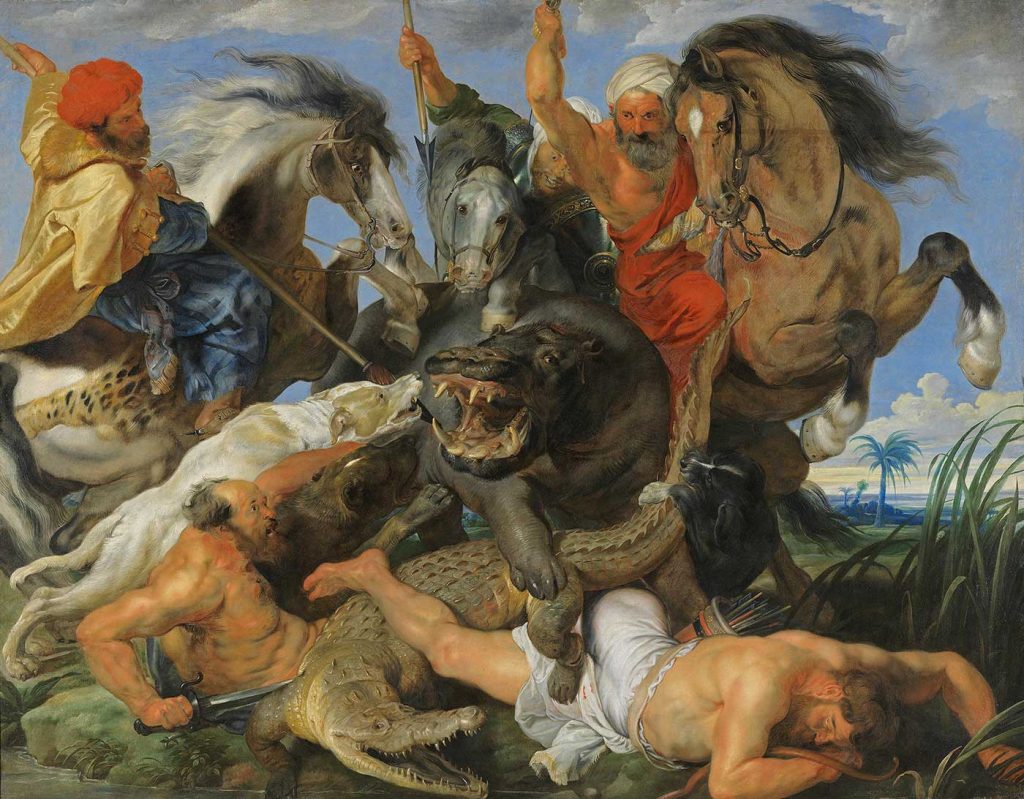
The Hippopotamus and Crocodile Hunt by Peter Paul Rubens was created in 1616. The painting is in Alte Pinakothek München. The size of the work is 248,3 x 321,3 cm and is made of oil on canvas.
About the Work
Rubens presumably received his inspiration for this subject following his close study of Classical art, as depictions of dramatic hunting scenes were very popular even at that time. The realistic depiction of the hippopotamus is presumably based on a stuffed animal that was on show in Rome in 1601. The painting is part of what was originally a four-part cycle of hunting scenes that the Elector Maximilian I had commissioned Rubens to complete for the Old Palace at Schleißheim. After being seized by Napoleonic troops this is the only one of the paintings to have found its way back to Munich.
The hunt takes place on the banks of the Nile, as indicated by a palm tree in the background. As hippopotami and crocodiles were considered dangerous nuisances, their destruction was a duty performed by noblemen. The hunting party comprises three men in orientalizing costume—mounted on Arabian horses, who hunt with lance and sword—and two valets clad in roughly-hewn jerkins—one of whom has been killed by one of the beasts. The enraged hippopotamus tramples the crocodile, as both are attacked by the hunters and hounds. The accurately-rendered physical appearances of the hippopotamus and crocodile contrast with contemporary renderings and reflect the period’s growing interest in empiricism and natural history. It has been suggested that Rubens may have traveled to Rome to view a temporarily-displayed dead hippopotamus preserved in brine prior to the painting of the picture.
About the Artist
Sir Peter Paul Rubens (28 June 1577 – 30 May 1640) was a Flemish artist and diplomat. He is considered the most influential artist of the Flemish Baroque tradition. Rubens’ highly charged compositions reference erudite aspects of classical and Christian history. His unique and immensely popular Baroque style emphasised movement, colour, and sensuality, which followed the immediate, dramatic artistic style promoted in the Counter-Reformation. Rubens was a painter producing altarpieces, portraits, landscapes, and history paintings of mythological and allegorical subjects. He was also a prolific designer of cartoons for the Flemish tapestry workshops and of frontispieces for the publishers in Antwerp.
Rubens was born and raised in the Holy Roman Empire (modern-day Germany) to parents who were refugees from Antwerp in the Duchy of Brabant in the Southern Netherlands (modern-day Belgium) and moved to Antwerp at about 12. In addition to running a large workshop in Antwerp that produced paintings popular with nobility and art collectors throughout Europe, Rubens was a classically educated humanist scholar and diplomat who was knighted by both Philip IV of Spain and Charles I of England. Rubens was a prolific artist. The catalogue of his works by Michael Jaffé lists 1,403 pieces, excluding numerous copies made in his workshop. Read more in Wikipedia
Order a reproduction of this work (printed on canvas)
